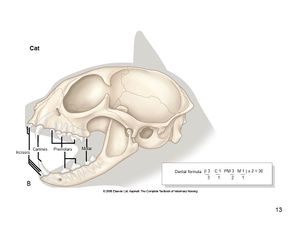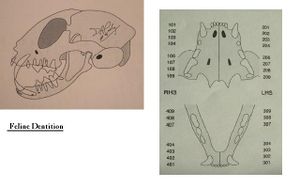Difference between revisions of "Dental Formula - Cat"
Jump to navigation
Jump to search
| Line 23: | Line 23: | ||
{{Lisa Milella reviewed | {{Lisa Milella reviewed | ||
|date = July 28, 2013}} | |date = July 28, 2013}} | ||
| + | |||
| + | {{Waltham}} | ||
| + | |||
{{OpenPages}} | {{OpenPages}} | ||
[[Category:Teeth - Anatomy & Physiology]] | [[Category:Teeth - Anatomy & Physiology]] | ||
| Line 28: | Line 31: | ||
[[Category:Oral Examination]] | [[Category:Oral Examination]] | ||
[[Category:LisaM reviewed]] | [[Category:LisaM reviewed]] | ||
| − | [[Category:Waltham | + | [[Category:Waltham reviewed]] |
Revision as of 10:33, 30 October 2014
Introduction
Cats are toothless at birth. Deciduous teeth are complete and functional within 2 months of birth. Permanent teeth are complete and functional by the end of the 6th month.
Formula for deciduous teeth: 2 (i3/3 c1/1 p3/2)
Formula for permanent teeth: 2 (I3/3 C1/1 P3/2 M1/1)
Premolars
In cats the maxillary 1st premolar and the mandibular 1st and 2nd premolars are normally missing.
Molars
A decrease in the number of molars leaves the cat with a shearing bite, rather than wider cusps for grinding.
Image from Aspinall, The Complete Textbook of Veterinary Nursing, Elsevier Health Sciences, All rights reserved
| This article was expert reviewed by Lisa Milella BVSc DipEVDC MRCVS. Date reviewed: July 28, 2013 |
| Endorsed by WALTHAM®, a leading authority in companion animal nutrition and wellbeing for over 50 years and the science institute for Mars Petcare. |
Error in widget FBRecommend: unable to write file /var/www/wikivet.net/extensions/Widgets/compiled_templates/wrt6742a6ab9294c5_16511787 Error in widget google+: unable to write file /var/www/wikivet.net/extensions/Widgets/compiled_templates/wrt6742a6ab98e935_19133951 Error in widget TwitterTweet: unable to write file /var/www/wikivet.net/extensions/Widgets/compiled_templates/wrt6742a6aba19a75_03933668
|
| WikiVet® Introduction - Help WikiVet - Report a Problem |

